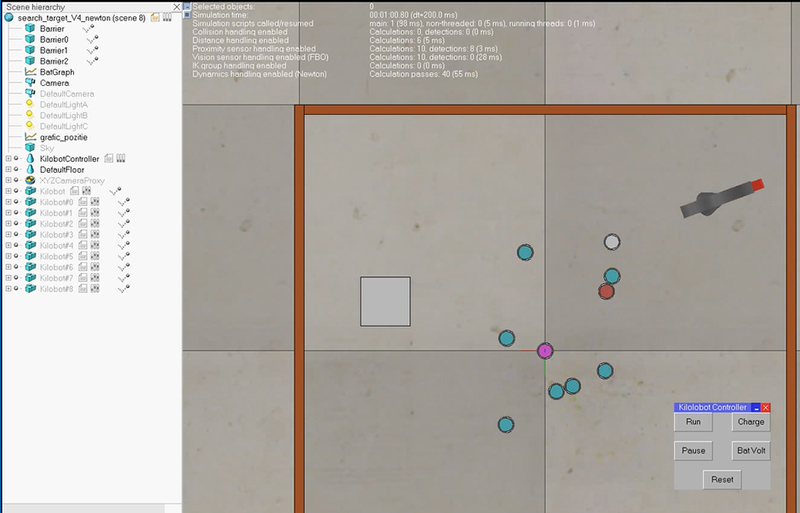
Discussing the Reality Gap by Comparing Physics Engines in Kilobot Simulations
Abstract
Keywords
Full Text:
PDFReferences
J. Zagal, J. Ruiz-del-Solar and P. Vallejos, "Back to reality: Crossing the reality gap in evolutionary robotics", IFAC Proceedings Volumes, vol. 37, no. 8, pp. 834-839, 2004.
J-P. Mouret and K. Chatzilygeroudis, “20 Years of Reality Gap: a few Thoughts about Simulators in Evolutionary Robotics”, GECCO ’17 Companion, Berlin, Germany, July 15-19, 2017, 4 pages
P. Christiano, Z. Shah, I. Mordatch, J. Schneider, T. Blackwell, J. Tobin, P. Abbeel and W. Zaremba "Transfer from simulation to real world through learning deep inverse dynamics model”, arXiv preprint arXiv:1610.03518, 2016
N. Jakobi, Ph. Husbands and I. Harvey, “Noise and the reality gap: The use of simulation in evolutionary robotics”, In European Conference on Artificial Life, Springer, Berlin, Heidelberg, 704–720, 1995
V. J. Zhong, R. Dornberger and Th. Hanne, "Comparison of the behavior of swarm robots with their computer simulations applying target-searching algorithms", International Journal of Mechanical Engineering and Robotics Research, 7(5). 2018
S. Koos, J. Mouret and S. Doncieux, "The transferability approach: crossing the reality gap in evolutionary robotics", IEEE Transactions on Evolutionary Computation, vol. 17, no. 1, pp. 122-145, 2013
J. C. Bongard, “Evolutionary robotics”, Communications of the ACM, 56(8), 74-83, 2013.
N. Jakobi, P.Husbands, and I. Harvey, “Noise and the reality gap: The use of simulation in evolutionary robotics”, In European Conference on Artificial Life (pp. 704-720). Springer, Berlin, Heidelberg, 1995.
S. Koos, J. B. Mouret and S. Doncieux, “Crossing the reality gap in evolutionary robotics by promoting transferable controllers”, In Proceedings of the 12th annual conference on Genetic and evolutionary computation (pp. 119-126), 2010.
S. Koos, J. B. Mouret and S. Doncieux, “The transferability approach: Crossing the reality gap in evolutionary robotics”, IEEE Transactions on Evolutionary Computation, 17(1), 122-145, 2012.
J. B. Mouret, S. Koos and S. Doncieux,”Crossing the reality gap: a short introduction to the transferability approach”, arXiv preprint arXiv:1307.1870, 2013.
J. C. Zagal and J. Ruiz-Del-Solar, “Combining simulation and reality in evolutionary robotics. Journal of Intelligent and Robotic Systems, 50(1), 19-39, 2007.
C. Hartland and N. Bredeche, “Evolutionary robotics, anticipation and the reality gap”, In 2006 IEEE International Conference on Robotics and Biomimetics (pp. 1640-1645). IEEE, 2006.
K. Y. Scheper and G. C. de Croon, “Abstraction, sensory-motor coordination, and the reality gap in evolutionary robotics”, Artificial Life, 23(2), 124-141, 2017.
K. Y Scheper and G. C. de Croon, ”Abstraction as a mechanism to cross the reality gap in evolutionary robotics”, In International Conference on Simulation of Adaptive Behavior (pp. 280-292). Springer, Cham, 2016.
N. Cruz and J. Ruiz-del-Solar, “Closing the simulation-to-reality gap using generative neural networks: Training object detectors for soccer robotics in simulation as a case study”, In 2020 International Joint Conference on Neural Networks (IJCNN) (pp. 1-8). IEEE, 2020.
F. Golemo, A. A. Taiga, A. Courville and P. Y. Oudeyer, “Sim-to-real transfer with neural-augmented robot simulation”, In Conference on Robot Learning (pp. 817-828), 2018.
K. Glette, A. L. Johnsen and E. Samuelsen, ”Filling the reality gap: Using obstacles to promote robust gaits in evolutionary robotics”, In 2014 IEEE International Conference on Evolvable Systems (pp. 181-186). IEEE, 2014.
M. Wahby, D. N. Hofstadler, M. K. Heinrich, P. Zahadat and H. Hamann, “An evolutionary robotics approach to the control of plant growth and motion: Modeling plants and crossing the reality gap”, In 2016 IEEE 10th International Conference on Self-Adaptive and Self-Organizing Systems (SASO) (pp. 21-30). IEEE, 2016.
W. Hoenig, C. Milanes, L. Scaria, T. Phan, M. Bolas and N. Ayanian, “Mixed reality for robotics”, In 2015 IEEE/RSJ International Conference on Intelligent Robots and Systems (IROS) (pp. 5382-5387). IEEE, 2015.
E. Freund and J. Rossmann, “Projective virtual reality: Bridging the gap between virtual reality and robotics”, IEEE transactions on robotics and automation, 15(3), 411-422, 1999.
T. Erez, Y. Tassa and E. Todorov, “Simulation tools for model-based robotics: Comparison of Bullet, Havok, MuJoCo, ODE and PhysX”, IEEE International Conference on Robotics and Automation (ICRA), 4397-4404, 2015
L. Pitonakova, M. Giuliani, A. Pipe and A. Winfield, "Feature and performance comparison of the V-REP, Gazebo and ARGoS robot simulators", Annual Conference Towards Autonomous Robotic Systems, 2018, pp 357-368
I. Bzhikhatlov and S. Perepelkina, "Research of robot model behaviour depending on model parameters using physic engines Bullet Physics and ODE", International Conference on Industrial Engineering, Applications and Manufacturing (ICIEAM), 2017, pp. 1-4
A. Roennau, F. Sutter, G. Heppner, J. Oberlaender and R. Dillmann, "Evaluation of physics engines for robotic simulations with a special focus on the dynamics of walking robots," 2013 16th International Conference on Advanced Robotics (ICAR), Montevideo, 2013, pp. 1-7
Y. Yu, J. Yang, X. Zan, J. Huang and X. Zhang, “Research of simulation in character animation based on physics engine,” International Journal of Digital Multimedia Broadcasting, vol. 2017, Article ID 4815932, 7 pages, 2017
E. Rohmer, S. P. N. Singh and M. Freese, "V-REP: A versatile and scalable robot simulation framework," 2013 IEEE/RSJ International Conference on Intelligent Robots and Systems, Tokyo, 2013, pp. 1321-1326
CoppeliaSim, “Dynamics engines general properties”, 2020 [Online]. Available:http://www.coppeliarobotics.com/helpFiles/en/dynamicsEngineDialog.htm
CoppeliaSim, “Simulation dialog”, 2020 [Online].
Available:http://www.coppeliarobotics.com/helpFiles/en/simulationPropertiesDialog.htm
CoppeliaSim, “Video recorder”, 2020 [Online].
Available:http://www.coppeliarobotics.com/helpFiles/en/aviRecorder.htm
DOI: https://doi.org/10.18196/jrc.25120
Refbacks
- There are currently no refbacks.
Copyright (c) 2020 Journal of Robotics and Control (JRC)

This work is licensed under a Creative Commons Attribution-ShareAlike 4.0 International License.
Journal of Robotics and Control (JRC)
P-ISSN: 2715-5056 || E-ISSN: 2715-5072
Organized by Peneliti Teknologi Teknik Indonesia
Published by Universitas Muhammadiyah Yogyakarta in collaboration with Peneliti Teknologi Teknik Indonesia, Indonesia and the Department of Electrical Engineering
Website: http://journal.umy.ac.id/index.php/jrc
Email: jrcofumy@gmail.com

